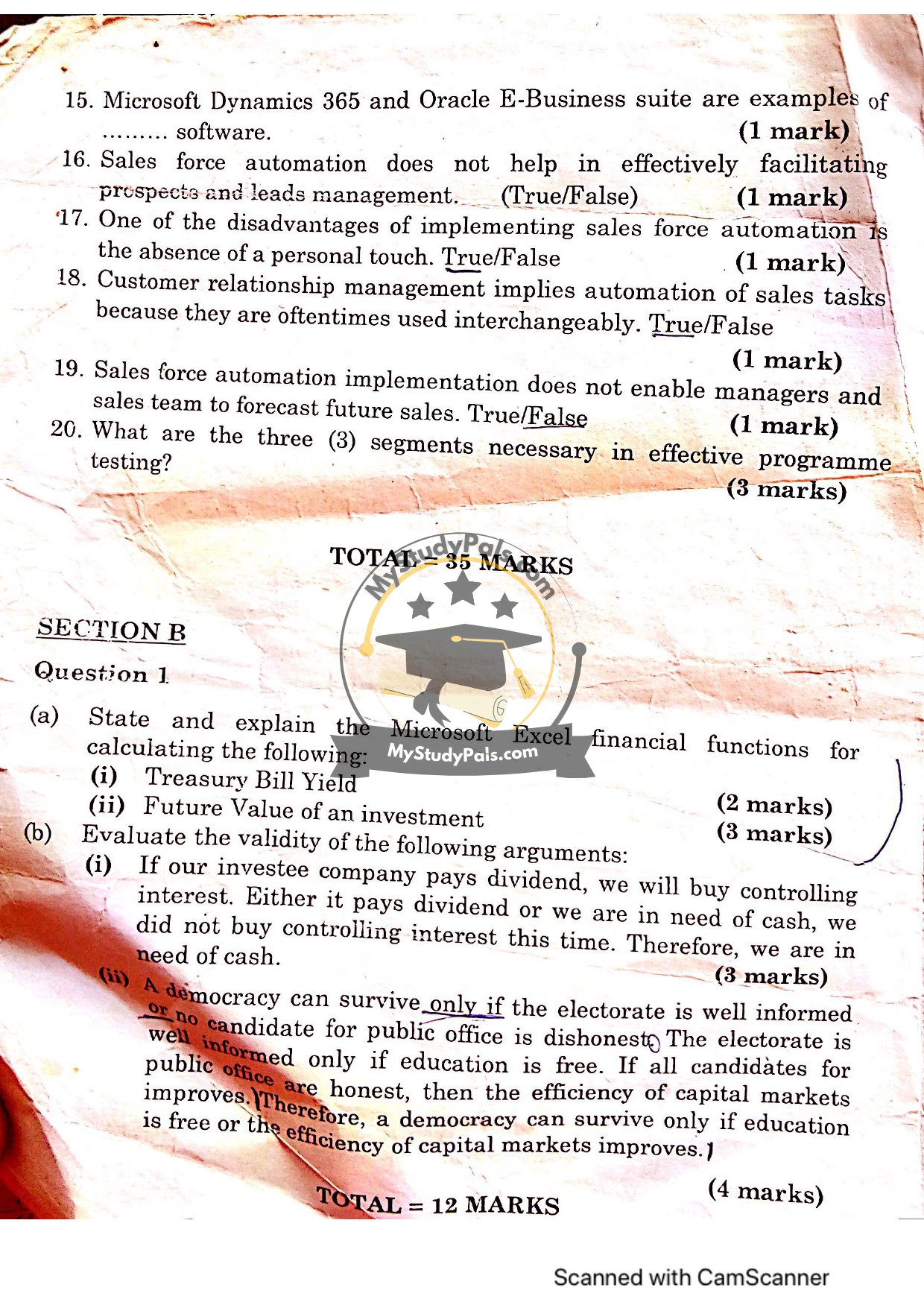ANWSER
Question 1:
Answer: Supply Chain Management is the oversight of goods/services, as they move in a process from supplier to manufacturer to wholesaler to retailer to consumer.
—
Question 2:
Answer: The three main flows of Supply Chain Management are:
1. Material flow
2. Information flow
3. Financial flow
—
Question 3:
Answer: The eight stages of programming are:
1. Problem definition
2. Algorithm design
3. Coding
4. Testing
5. Debugging
6. Documentation
7. Implementation
8. Maintenance
—
Question 4:
Answer: Supply chain management software is classified into planning applications and execution applications.
—
Question 5:
Answer: Enterprise Resource Planning (ERP) is a company-wide computer software system used to manage and coordinate all resources, information, and functions of a business from shared data stores.
—
Question 6:
Answer: A Sales Management System is the process of combining sales force automation with a marketing information system.
—
Question 7:
Answer: The two main problems addressed by Supply Chain Management are:
1. Demand forecasting inaccuracies
2. Coordination inefficiencies among supply chain partners
—
Question 8:
Answer: Operational CRM relates to operations that ultimately affect the activities of the front office.
—
Question 9:
Answer: Interactions with partners under CRM are referred to as Partner Relationship Management (PRM).
—
Question 10:
Answer: Four variants of CRM are:
1. Operational CRM
2. Analytical CRM
3. Collaborative CRM
4. Strategic CRM
—
Question 11:
Answer: The four functional areas of ERP software are:
1. Finance and Accounting
2. Human Resources
3. Supply Chain Management
4. Customer Relationship Management
—
Question 12:
Answer: The four basic types of instructions in programming are:
1. Input/Output
2. Arithmetic/Logic
3. Control (e.g., loops, conditionals)
4. Data movement
—
Question 13:
Answer:
– ASCII: American Standard Code for Information Interchange
– EBCDIC: Extended Binary Coded Decimal Interchange Code
—
Question 14:
Answer: The seven principles of good programming are:
1. Clarity
2. Simplicity (KISS)
3. Modularity
4. Efficiency
5. Maintainability
6. Reusability
7. Scalability
—
Question 15:
Answer: Microsoft Dynamics 365 and Oracle E-Business Suite are examples of ERP software.
—
Question 16:
Answer: False. Sales force automation facilitates prospects and leads management.
—
Question 17:
Answer: True. A disadvantage of sales force automation is the absence of a personal touch.
—
Question 18:
Answer: False. CRM encompasses more than just automation of sales tasks.
—
Question 19:
Answer: False. Sales force automation enables forecasting future sales.
—
Question 20:
Answer: The three segments of effective program testing are:
1. Unit testing
2. Integration testing
3. System testing
—
### Section B
Question 1(a):
Answer:
(i) Treasury Bill Yield: Excel function `TBILLYIELD(settlement, maturity, pr)`
(ii) Future Value of an investment: Excel function `FV(rate, nper, pmt, [pv], [type])`
Question 1(b):
Answer:
The argument is valid. If the investee company did not pay a dividend (as no controlling interest was bought), the second premise (“either dividend or need cash”) implies “need of cash” must be true.
Question 1(c):
Answer:
The conclusion is valid. Symbolically:
– Premises:
1. \( D \rightarrow (E \lor \neg C) \)
2. \( E \leftrightarrow F \)
3. \( C \rightarrow M \)
– Conclusion: \( D \rightarrow (F \lor M) \)
Using substitution and logical equivalences, the conclusion follows.
—
Question 2(a):
Answer:
Flowchart Steps:
1. Start
2. Input store location, manager name, year
3. For each item (Biro, Pencil, Ruler, Eraser):
– Input monthly demand, ordering cost, holding cost
– Calculate EOQ = SQRT((2 * Demand * Ordering Cost) / Holding Cost)
– Calculate Minimum Annual Cost = (Demand/EOQ)*Ordering Cost + (EOQ/2)*Holding Cost
4. Sum total minimum annual inventory cost
5. Display output in table format
6. End
Question 2(b):
Answer (Q-Basic Program):
“`qbasic
CLS
PRINT “OJASOPE PLC”
PRINT “RAW MATERIAL INVENTORY SUMMARY SHEET”
INPUT “STORE LOCATION: “; loc$
INPUT “STORE MANAGER’S NAME: “; mgr$
INPUT “YEAR: “; yr$
DIM items$(4), demand(4), orderCost(4), holdingCost(4), eoq(4), minCost(4)
items$ = (“Biro”, “Pencil”, “Ruler”, “Eraser”)
FOR i = 1 TO 4
PRINT “ITEM: “; items$(i)
INPUT “Monthly Demand: “; demand(i)
INPUT “Ordering Cost per Order: “; orderCost(i)
INPUT “Holding Cost per Unit: “; holdingCost(i)
eoq(i) = SQRT((2 * demand(i) * orderCost(i)) / holdingCost(i))
minCost(i) = (demand(i)/eoq(i)) * orderCost(i) + (eoq(i)/2) * holdingCost(i)
NEXT i
PRINT “TOTAL MINIMUM ANNUAL INVENTORY COST: “; SUM(minCost)
END
“`
—
Question 3(a):
Answer: Four critical strategies before investing in CRM:
1. Align CRM goals with business objectives
2. Evaluate cost vs. ROI
3. Ensure integration with existing systems
4. Plan for user training and adoption
Question 3(b):
Answer: Key characteristics of ERP:
1. Centralized database
2. Real-time data processing
Question 3(c):
Answer: Benefits of ERP:
1. Streamlined business processes
2. Enhanced data accuracy and accessibility
3. Improved decision-making
4. Reduced operational costs





